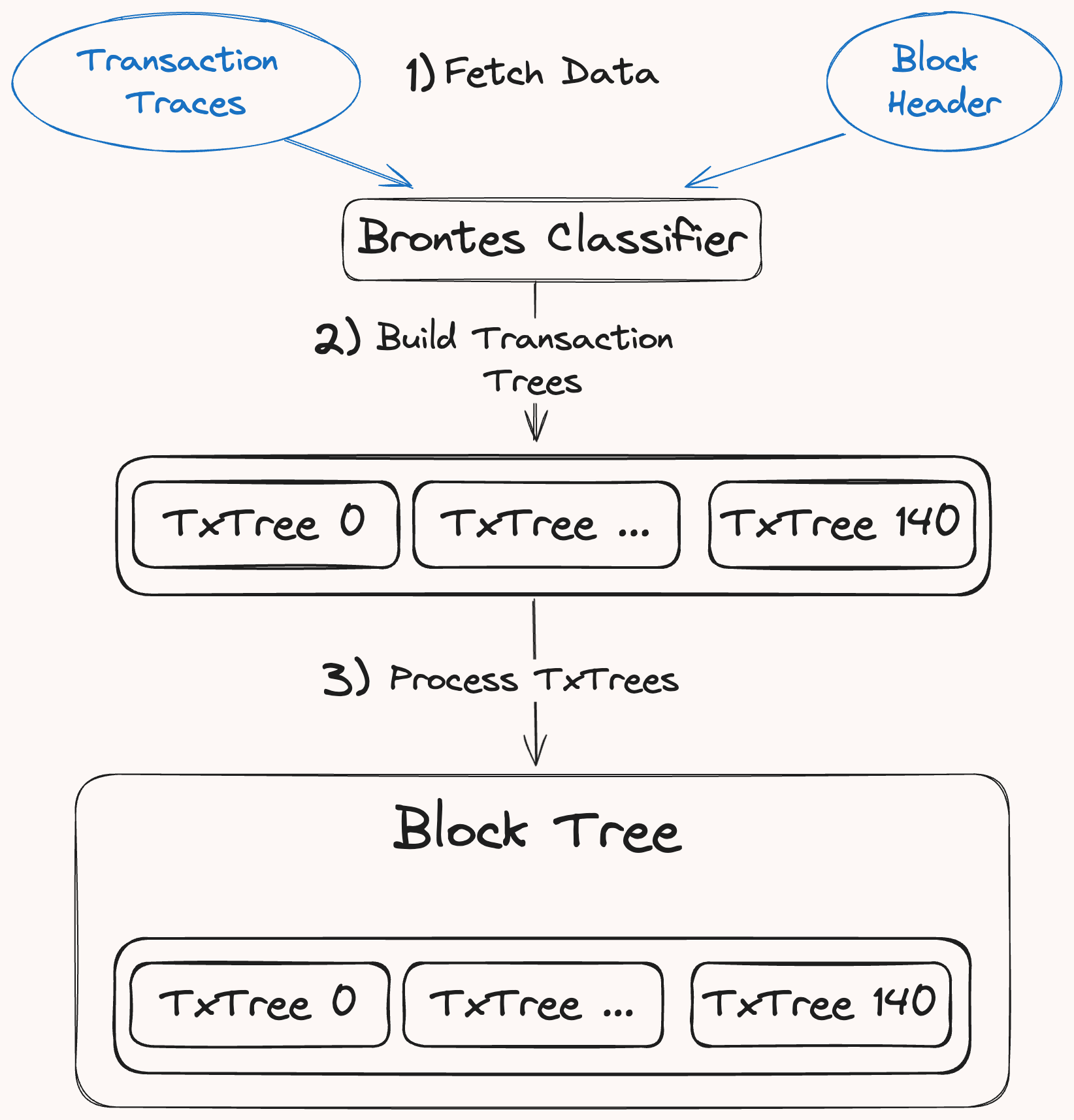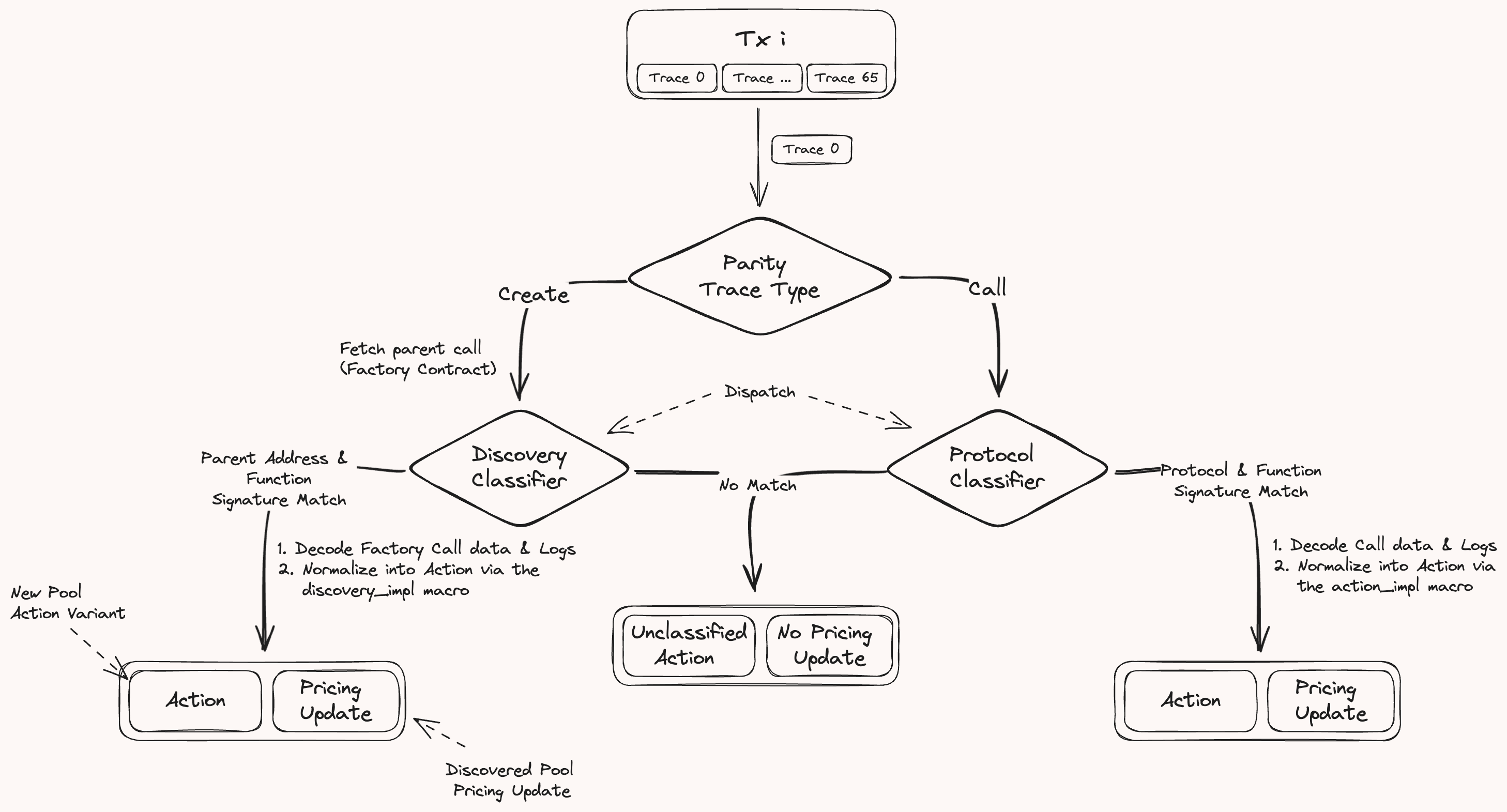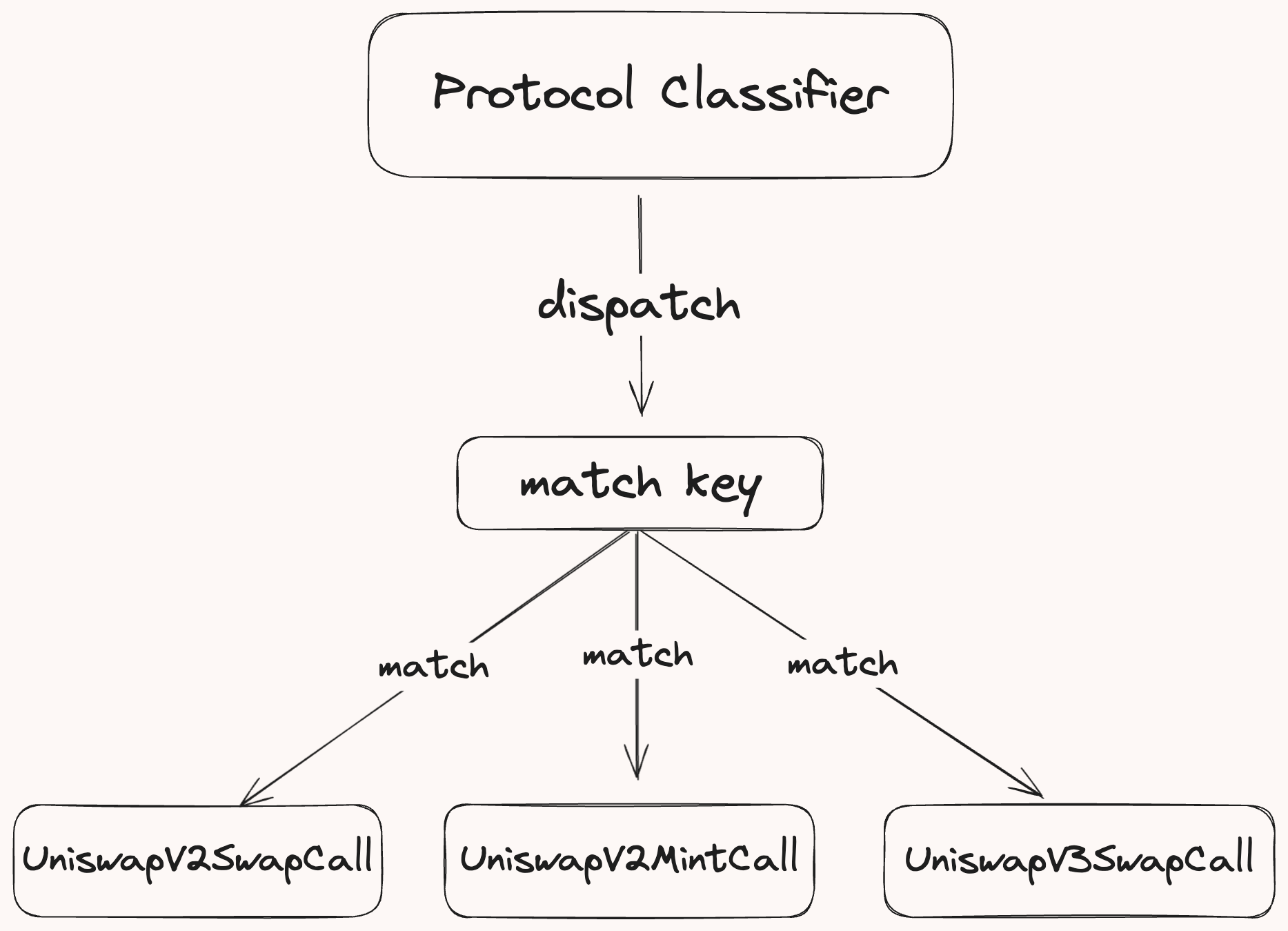Block Tree
The BlockTree decodes, and classifies a block's transaction traces into a collection of TransactionTrees, each representing a transaction's call hierarchy.
A TransactionTree structures EVM traces as a series of Action, which serve as the nodes of the tree. Each Action normalizes core DeFi operations, such as swaps, flash loans, and mints. This approach harmonizes idiosyncratic protocol implementations, generalizing their representation to establish a consistent analytical framework.
Block Tree Building
At a high level, generating the Block Tree involves three primary steps:

-
Fetching Raw EVM Data: Brontes retrieves the transaction traces and the
BlockHeaderfor a block, first querying the database. If the data is not available, it is generated using a customrevm-inspectorand cached in the database for future use. -
Tree Building: Traced transactions are individually passed to the TxTree builder which descends through the call hierarchy, classifying each trace into an
Action. Decoding and normalization occur via thedispatchmacro which routes call data to itsProtocolClassifier. See the Action Classification section for more. -
Processing: The newly built BlockTree undergoes sanitization to account for tax tokens and duplicate transfers. It also classifies multi-call frame actions, which span multiple traces. More on this in the Multi Call Frame Classification section.
Action Classification
Each transaction trace is classified into an Action and an optional DexPriceMsg if it should be priced. The diagram below illustrates the classification process:

Protocol Classifier
The ProtocolClassifier, generated by the action_dispatch proc macro, orchestrates the call trace classification. This macro creates the dispatch function which routes each trace to its action classifier based on the protocol and function call. These classifiers decode and normalize trace data into a standardized Action. To incorporate new classifiers, developers simply add them in the macro invocation.
Here is an example of how you'd declare available classifiers using the action_dispatch macro:
action_dispatch!(
ProtocolClassifier,
UniswapV2SwapCall,
PancakeSwapV2BurnCall,
UniswapV3SwapCall,
...
);
Action Dispatch
The dispatch function routes each call trace to its classifiers through these steps:

-
Retrieve Protocol Information: Fetches the protocol associated with the trace's target address by querying the
AddressToProtocolInfotable, consistently updated by theDiscoveryClassifier. -
Create a Match Key: Append the protocol to the function signature to form a match key.
-
Identify the action classifier: Compares the match key against the set of classifiers. If a match is found,
decode_call_traceis called on the corresponding classifier, passingCallInfo, database connection (db_tx),block, and transaction index (tx_idx) as inputs.
Classifying the Action
The decode_call_trace method of the action classifier, generated by the action_impl proc macro, decodes & classifies the trace. Developers specify the expected data inputs and the transformation logic, and the macro handles all aspects of data decoding.
Understanding the action_impl Macro
The action_impl macro generates all necessary decoding logic based on specified flags — namely call data, logs, and return data — allowing developers to focus solely on how the data is transformed into a normalized Action.
Here’s a breakdown of the macro's usage:
action_impl!(
ProtocolPath, // Path to the protocol module
PathToCall, // Path to the alloy binding for that function
CallType, // The type of action, e.g., Swap, Mint
[LogType], // Array of log types, in the order they are emitted
logs: bool, // Flag to specify if logs should be decoded
call_data: bool, // Flag to specify if call data should be decoded
return_data: bool // Flag to specify if return data should be decoded
call_function: ExprClosure, // Closure defining the logic to construct the action
);
Example: Classifying a Maker PSM Swap Action
Let's consider this macro invocation to classify swap actions for the Maker PSM module.
action_impl!(
Protocol::MakerPSM, // Path to the protocol module
crate::MakerPSM::buyGemCall, // Specifies the function
Swap, // Action type
[BuyGem], // Log type emitted by the function
call_data: true, // Decode call data
logs: true, // Decode log data
|info: CallInfo,
call_data: buyGemCall,
log_data: MakerPSMBuyGemCallLogs,
db_tx: &DB| {
// Custom logic to process the data and classify the action into a swap action
// Fetches the details of this contract
let details = db_tx.get_protocol_details(info.target_address)?;
// For the PSM, the token0 should always be set to DAI and token1
// is the gem (USDC or USDP)
let [token_0, token_1] = [details.token0, details.token1];
// Retrieves the token symbol and decimals
let t0_info = db_tx.try_fetch_token_info(token_0)?;
let t1_info = db_tx.try_fetch_token_info(token_1)?;
// Extracts the amount of tokens being bought from the decoded call data
let amount_out = call_data.gemAmt.to_scaled_rational(t1_info.decimals);
// Extracts the fee in DAI decimals from the decoded log
let fee = log_data.buy_gem_field?.fee;
let fee_amount = fee.to_scaled_rational(t0_info.decimals);
// The amount of DAI being spent, amount out + fee
let amount_in = &amount_out + &amount_out * fee_amount;
// Returns the normalized swap action
Ok(NormalizedSwap {
protocol: Protocol::MakerPSM,
trace_index: info.trace_idx,
from: info.from_address,
recipient: call_data.usr,
pool: info.target_address,
token_in: t0_info,
token_out: t1_info,
amount_in,
amount_out,
msg_value: info.msg_value,
})
}
);
In this implementation:
- The required inputs are specified via the flags (
call_dataandlogs). - The closure uses the decoded call data & logs to normalize the call into a
NormalizedSwapaction.
Discovery Classifier
The DiscoveryClassifier, generated by the discovery_dispatch proc macro, manages the indexing of new protocol contracts. This macro creates the dispatch function which routes each create trace to its factory contract classifier. These classifiers the create trace a corresponding factory contract initialization function into a NormalizedNewPool action variant. To incorporate discovery for a protocol, developers simply add them in the macro invocation.
Here is an example of how you'd declare available factory classifiers using the discovery_dispatch macro:
discovery_dispatch!(
DiscoveryClassifier,
UniswapV2Discovery,
UniswapV3Discovery,
PancakeSwapV3Discovery,
CurveV1MetaDiscovery,
CurveV2PlainDiscovery0,
...
);
Discovery Dispatch
The dispatch function routes each call trace to its classifiers through these steps:
-
Create a Match Key: Gets the immediate parent call of the create trace to retrieve the factory contract address and the factory contract initialization function signature. Appends the factory address and the function signature to form a match key.
-
Identify the factory classifier: Compares the match key against the set of factory classifiers. If a match is found,
decode_create_traceis called on the corresponding classifier, passing thetracer,deployed_address,parent_calldata(factory contract function call), andtrace_idxas inputs.
Classifying the Contract
The decode_call_trace method of the factory classifier, generated by the discovery_impl proc macro, decodes the factory deploy function call to extract the contract parameters. Developers specify the factory address, function and transformation logic, and the macro handles the decoding.
Understanding the discovery_impl Macro
Here’s a breakdown of the macro's usage:
discovery_impl!(
UniswapV2Discovery, // DiscoveryName
crate::UniswapV2Factory::createPairCall, // Path::To::Factory::DeployCall
0x5C69bEe701ef814a2B6a3EDD4B1652CB9cc5aA6f, // Factory Address
|deployed_address: Address, trace_index: u64,
_, // Here the tracer is not used
call_data: createPairCall| async move {
// Custom logic to classify the action into a new pool action
// Extracts the token addresses from the factory deploy call data
let token_a = call_data.tokenA;
let token_b = call_data.tokenB;
// Returns the normalized new pool action
vec![NormalizedNewPool {
pool_address: deployed_address,
trace_index,
protocol: Protocol::UniswapV2,
tokens: vec![token_a, token_b],
}]
}
);
In this implementation:
- The closure uses the decoded call data from the factory deploy call and the deployed address from the CREATE trace to create a
NormalizedNewPoolaction which contains all relevant information about this newly created Uniswap pool.
Adding a step for generating the necessary bindings for the Uniswap V3 factory and pool contracts will ensure that users have all the components they need for a complete classifier setup. Here's how to integrate this information into your existing guide:
Implementing a New Classifier: Uniswap V3 Example
Step 1: Generate Contract Bindings
Before implementing classifiers, you'll need to generate bindings for the Uniswap V3 factory and pool contracts. This involves the following steps:
- Obtain the ABI for both the factory and pool contracts.
- Place these ABI files in the classifier-abis folder.
- Use the alloy
sol!macro to generate the contract bindings. Add the invocation tobrontes_classifierlib.rsfile
sol!(UniswapV3Factory, "./classifier-abis/UniswapV3Factory.json");
sol!(UniswapV3, "./classifier-abis/UniswapV3.json");
Note
The
action_implanddiscovery_implmacros will automatically import the generated bindings.
Finally, add the protocol name to the Protocol enum in protocol.rs.
Step 2: Adding a Discovery Classifier for Uniswap V3
Implement a discovery classifier for the Uniswap V3 pools. This classifier will identify and classify new pools created via the Uniswap V3 Factory.
use alloy_primitives::Address;
use brontes_macros::discovery_impl;
use brontes_pricing::Protocol;
discovery_impl!(
UniswapV3Discovery, // Discovery classifier name
crate::UniswapV3Factory::createPoolCall, // Path to the deploy call binding
0x1F98431c8aD98523631AE4a59f267346ea31F984, // Factory address
|deployed_address: Address, trace_index: u64,
call_data: createPoolCall, _| async move {
// Extract the pool token addresses from the factory deploy function call data
let token_a = call_data.tokenA;
let token_b = call_data.tokenB;
// Return the normalized new pool action
vec![NormalizedNewPool {
pool_address: deployed_address,
trace_index,
protocol: Protocol::UniswapV3,
tokens: vec![token_a, token_b],
}]
}
);
Add the new discovery classifier to the discovery_dispatch! macro in the classifiers mod.rs:
discovery_dispatch!(
DiscoveryClassifier,
SushiSwapV2Discovery,
UniswapV2Discovery,
UniswapV3Discovery
);
Step 3: Implementing an Action Classifier for Uniswap V3 Mint Function
Define an action classifier for the Uniswap V3 mint function to process mint actions:
use brontes_macros::action_impl;
action_impl!(
Protocol::UniswapV3,
crate::UniswapV3::mintCall, // Path to the alloy binding for the mint function
Mint, // Action type
[Mint], // Log type emitted by the mint function
return_data: true, // Decode return data
logs: true, // Decode logs
call_data: true, // Decode call data
|
info: CallInfo,
call_data: mintCall,
return_data: mintReturn, _logs: UniswapV3MintCallLogs, db_tx: &DB| {
// Extract the token deltas from the decoded return data
let token_0_delta = return_data.amount0;
let token_1_delta = return_data.amount1;
// Fetch the protocol details from the database
let details = db_tx.get_protocol_details_sorted(info.target_address)?;
let [token_0, token_1] = [details.token0, details.token1];
// Fetch the token info from the database
let t0_info = db_tx.try_fetch_token_info(token_0)?;
let t1_info = db_tx.try_fetch_token_info(token_1)?;
// Convert U256 to malachite Rational using the token decimals
let am0 = token_0_delta.to_scaled_rational(t0_info.decimals);
let am1 = token_1_delta.to_scaled_rational(t1_info.decimals);
// Return the normalized mint action
Ok(NormalizedMint {
protocol: Protocol::UniswapV3,
trace_index: info.trace_idx,
from: info.from_address,
recipient: call_data.recipient,
pool: info.target_address,
token: vec![t0_info, t1_info],
amount: vec![am0, am1],
})
}
);
- Check out the full Uniswap V3 action implementation, which also includes swap, burn, and collect functions here.
Register the new action classifier in the action_dispatch! macro in the classifiers mod.rs:
action_dispatch!(
ProtocolClassifier,
UniswapV2SwapCall,
UniswapV2MintCall,
UniswapV3MintCall
);
And that's it! You've successfully implemented support for automated pool discovery and mint action classification for Uniswap V3.
Multi Call Frame Classification
In certain scenarios, actions extend beyond a single trace and involve nested actions that span through the child call frames, such as flash loans or aggregator swaps. Multi call frame classification is designed to handle such scenarios, where a single call-frame is insufficient for complete action classification.
Process
- Mark Complex Classification during classification: When we classify a trace into an action that requires multi call frame classification, we mark the trace index for retrieval during the multi call frame classification phase.
- Request Retrieval: After all traces are classified, retrieve multi call frame classification requests and process each request in reverse transaction tree order. This ensures that nested complex classifications are handled correctly.
- Child Node Retrieval: For each classification request, retrieve all child nodes relevant to the action, as specified by the
MultiCallFrameClassifierimplementation.
Example: AaveV2 Liquidation
Consider the AaveV2 classifier for a liquidation action, which requires fetching all child transfer actions. Here’s how the classifier is implemented:
fn create_classifier(request: MultiFrameRequest) -> Option<MultiCallFrameClassification<Action>> {
Some(MultiCallFrameClassification {
trace_index: request.trace_idx,
tree_search_builder: TreeSearchBuilder::new().with_action(Action::is_transfer),
parse_fn: Box::new(parse_v2_v3),
})
}
This function retrieves the relevant child actions for a node and passes them to a parsing function that finalizes the classification of the complex action. These actions are then integrated into the main action and pruned from the tree to prevent duplication.
fn parse_v2_v3(this: &mut Action, child_nodes: Vec<(NodeDataIndex, Action)>) -> Vec<NodeDataIndex> {
let this = this.try_liquidation_mut().unwrap();
child_nodes.into_iter().find_map(|(index, action)| {
if let Action::Transfer(transfer) = action {
if transfer.to == this.liquidator {
this.liquidated_collateral = transfer.amount;
return Some(index);
}
}
None
})
.map(|e| vec![e])
.unwrap_or_default()
}
Classifier Configuration
The Classifier configuration file, located at config/classifier_config.toml, allows you to manually map contract addresses to their corresponding protocols when automated discovery is impractical.
Configuration Example
Configure classifiers in TOML format as shown:
[AaveV3."0x5faab9e1adbddad0a08734be8a52185fd6558e14"]
init_block = 18979624
[[AaveV3."0x5faab9e1adbddad0a08734be8a52185fd6558e14".token_info]]
address = "0xa0b86991c6218b36c1d19d4a2e9eb0ce3606eb48"
decimals = 6
symbol = "USDC"
[[AaveV3."0x5faab9e1adbddad0a08734be8a52185fd6558e14".token_info]]
address = "0x2260fac5e5542a773aa44fbcfedf7c193bc2c599"
decimals = 8
symbol = "WBTC"
This configuration populates the AddressToProtocolInfo table, which maps contract addresses to detailed protocol data, which is used in the dispatch functions to apply the correct classifiers based on the contract address and protocol.
Important Notes
- Protocol Compatibility: The protocol name in the configuration must correspond to one listed in the protocol enum in
protocol.rs. - Token Information: Includes blockchain addresses, decimals, and symbols.
- Initialization Block: Marks at what block the contract was created.